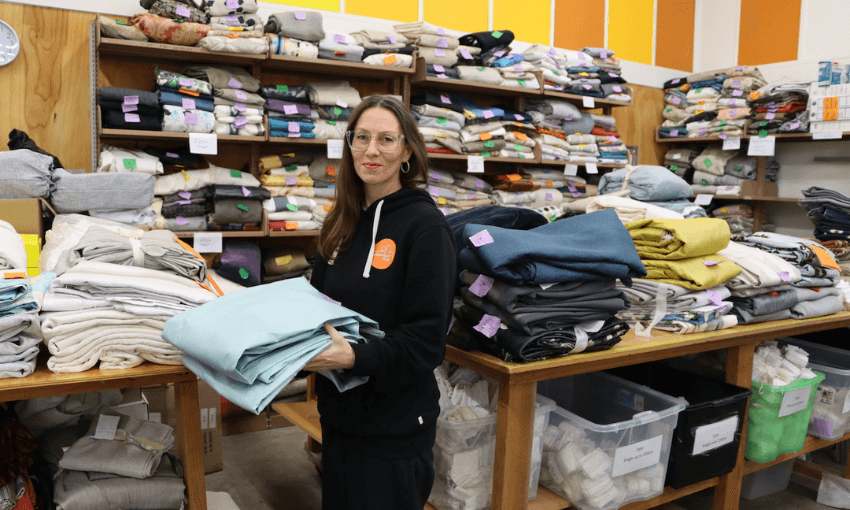Around the country, a network of curtain banks make and provide curtains that keep homes warm and electricity bills down. Demand is ever-growing, and they’re sewing frantically to keep up.
If you walk through Habitat for Humanity’s Ōtara superstore, down the external and currently chilly alleyway full of ceramic sinks, toilets and baths, there’s another reclaimed industrial building. On its bright blue painted side, there’s a white sign reading “CURTAIN BANK” over a set of glass doors. Inside, two industrial sewing machines are humming, their operators carefully running pieces of fabric and curtain tape through straight as an arrow.
The irons are hot. There’s three big pattern-cutting tables and along the walls, shelves with bundles of curtains labelled with order numbers or dimensions. This is Habitat’s curtain bank, where last year the team sent out more curtains than ever before – 11,215 curtains for 732 families. It’s not like a food bank where people are only given what’s already there – almost every curtain is customised.
This bank is just one of a network of 22 curtain banks scattered from Auckland all the way down to Invercargill. Most of the curtain banks don’t stand alone – they’re part of the Healthy Homes Initiative, with Health New Zealand saying curtains are the highest identified need – ahead of heaters, bedding, mould cleaning kits, blankets, window squeegees and small repairs. The Healthy Homes Initiative, which aims to help more families live in warm, dry homes, has been successful and cost-effective in reducing child hospitalisations, improving school attendance, reducing energy hardship and a raft of other health and social benefits.
And yet, there’s not a mention of curtains in the Healthy Homes Standards. That means that landlords are not obliged to provide them, and so many don’t, especially at the lower end of the rental market. Many houses seen by Healthy Homes teams don’t have any curtains at all, or they might be thin or mouldy. Sometimes people have venetian blinds or roller blinds that don’t provide a thermal barrier. Often, people don’t realise how much of a difference curtains can make.
In Wellington, orders are closed at the city’s only curtain bank, run by Sustainability Trust. The team of two full-time staff and 27 volunteers is still working on curtain orders from last year, and it’s not just sewing. Here, as well as providing curtains, the team aims to divert as much waste as possible from landfill. All the curtains begin with a donation, usually of a pre-loved curtain and occasionally of fabric. Donations need to be unpacked and checked for mold which is either cut, pulled or unpicked away. The rest is measured, laundered and filed in one of two little rooms that serve as the curtain library. Curtain tracks and their brackets are donated too. In another room they’re cleaned and refurbished. There’s also gliders, hooks and tape to sort and store. “I keep on taking up more space,” says Julie Gunn, the curtain bank manager. “There’s just a lot happening. We are getting lots of curtain donations coming in, which is good, but we need to keep up.”
Then comes actually filling orders. Measurements of the windows of a household come through home visits by the trust’s Heathy Homes team or other referral pathways. Best practice guidelines are followed so that the curtains are as effective as possible. The length must be “to the floor and a little bit more,” says Gunn, and the width must allow for plenty of folds and for the curtain to extend past the window frame, “so there’s less chance for that warm air to sneak in behind the curtain”. It’s also important that the curtains are lined to create an insulating layer of air. Gunn compares it to the puff in a puffer jacket. Ideally, the fabric is a tightly woven natural fibre, heavy and thick. Thermal backed curtains aren’t great as the backing deteriorates and can’t easily be washed.
“There’s so much love and care that goes into each step of the process,” says Gunn. But the curtain bank needs more than that to run. At the end of the year, its major sponsorship is coming to an end. Even that sponsorship doesn’t cover costs – the shortfall is made up for by the Sustainability Trust. “We apply to every funding opportunity that comes along,” says Gunn. “We have noticed that there is more and more demand on the charitable and philanthropic funding that is available. That’s tough, because everyone applying to those funding opportunities is doing really good and really important work.”
Up in Auckland, the Habitat curtain bank services households across the city and in Northland. They can keep their wait times down – about two months in summer and six in winter – because compared to other curtain banks they are well-resourced and staffed. They purchase premade curtains and new curtain fabric, lining, tape and tracks. Still, even the premade curtains are almost always customised in some way to properly fit the window they are heading to. “These are top-end custom curtains,” says Jane, an experienced sewist there. She’s pressing a crisp seam on a chocolate brown curtain with flocked flowers. “For the most part people are really appreciative,” she says.
A national network of curtain banks tries to meet yearly. A couple of years ago, Curtain Call, a group that advocates adding curtains to the Healthy Homes Standards, sprung from the network. Curtain Call argues that leaving curtains out leaves a gap in the legislation, and in 2023 publicly campaigned, met with politicians and petitioned the government. With the coalition government, they changed their tack. Leana Hunt, operations manager in Habitat’s northern region, says “it’s not their [the government’s] priority right now”. Curtain Call is continuing to raise awareness among communities, without directly petitioning politicians.
For as long as curtains aren’t in the standards, curtain banks will continue to face more demand than they can keep up with, but not without joy. “It is sad that there is so much need out there,” says Gunn from Wellington, “but it is a wonderful thing to be involved with.” When families open up their boxes of curtains, “I want all of that love to spill out onto them, because we love what we do.”



